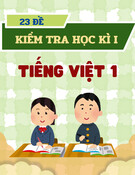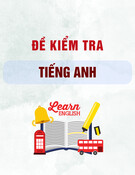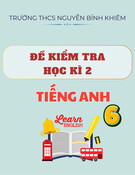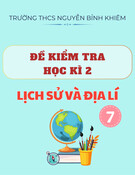
Trang 1/4 - Mã đề thi 408
SỞ GIÁO DỤC VÀ ĐÀO TẠO
NGHỆ AN
ĐỀ THI CHÍNH THỨC
(Đề thi có 04 trang)
KỲ KHẢO SÁT CHẤT LƯỢNG KẾT HỢP THI THỬ
LỚP 12 – ĐỢT 1, NĂM HỌC 2020 - 2021
Bài thi: TIẾNG ANH
Thời gian làm bài: 60 phút; không kể thời gian phát đề
Họ và tên thí sinh:....................................................................
Số báo danh: ............................................................................
Mark the letter A, B, C, or D to indicate the word that differs from the other three in the position of primary
stress in each of the following questions.
Question 1: A. hospital B. equipment C. benefit D. memory
Question 2: A. design B. compete C. attract D. enter
Mark the letter A, B, C, or D on your answer sheet to indicate the sentence that is closest in meaning to
each of the following questions.
Question 3: “We’re having a reunion this weekend. Why don’t you come?” John said to us.
A. John suggested we coming to a reunion that weekend.
B. John simply asked us why we wouldn’t come to a reunion that weekend.
C. John asked us why we didn’t come to a reunion this weekend that weekend.
D. John cordially invited us to a reunion that weekend.
Question 4: Many people believe that Egyptian pyramids were built by aliens.
A. Egyptian pyramids are believed to build by aliens.
B. Egyptian pyramids are believed to have built by aliens
C. Aliens are believed to build Egyptian pyramids.
D. It is believed that Egyptian pyramids were built by aliens.
Question 5: Access to the library computer facilities is open to students.
A. Students can freely assess the library computer service.
B. Computers in the library are not used for students.
C. Students are not allowed to use library computers.
D. The library computer facilities are accessible to students.
Mark the letter A, B, C, or D on your answer sheet to indicate the word(s) CLOSEST in meaning to the
underlined word(s) in each of the following questions.
Question 6: All of my classmates are always willing to support me whenever I am in trouble.
A. likely B. ready C. reluctant D. obliged
Question 7: We heard the sound of an approaching car, so we ran away.
A. running B. coming C. breaking D. moving
Read the following passage and mark the letter A, B, C, or D on your answer sheet to indicate the correct
answer to each of the questions from 8 to 14.
RELIGION IN JAPAN
The native religion of Japan is Shintou, an indigenous folk religion that finds spirits abounding in nature.
There is no formal creed, or indeed much of any philosophy behind it. It basically allows followers a way of currying
favour with various gods so as to receive good luck. Even today, many older Japanese will, when walking past a
shrine, turn and bow to the spirits within.
Mahayana Buddhism arrived in Japan in the 6th century. Over the centuries, it grew in prestige and
divided into sects. Today, the most well-known forms of Japanese Buddhism are Souka Gakkai - the quasi-political
religious group that has significant political clout - and Zen Buddhism.
Shintou and Buddhism have a long and intertwined history in Japan, and it is only in the past hundred
years or so that they have been separated. Even today things can be confusing, as the design of Shintou shrines
and Buddhist temples can look very much alike. The key tip: If there's a torii (a large, two-legged arch) standing at
the entrance of the grounds, it's a Shintou shrine; if not, it's a Buddhist temple.
A visit to a shrine first involves the visitor washing his hands and mouth at a pool in front of the shrine.
Then he will make an offering of money, ring the gong, bow twice, clap twice and bow twice more.
To an outsider's eyes, there are a few differences with regards to religion as it is practised in Japan. The
most obvious is that in Japan it is perfectly permissible - indeed, almost expected - that people can be both
Buddhist and Shintoist at the same time. Many Japanese, for example, will get married in a Shintou ceremony, but
will have Buddhist rites at their funerals.
In fact, many Japanese seem to avoid people who appear overtly religious. Occasionally you will meet a
proselytiser of some religion on the street, but in general, people seem to think that that kind of behaviour is
reserved for cult members. People have strong memories of the cult that killed and injured so many people on the
Mã đề thi 408







































